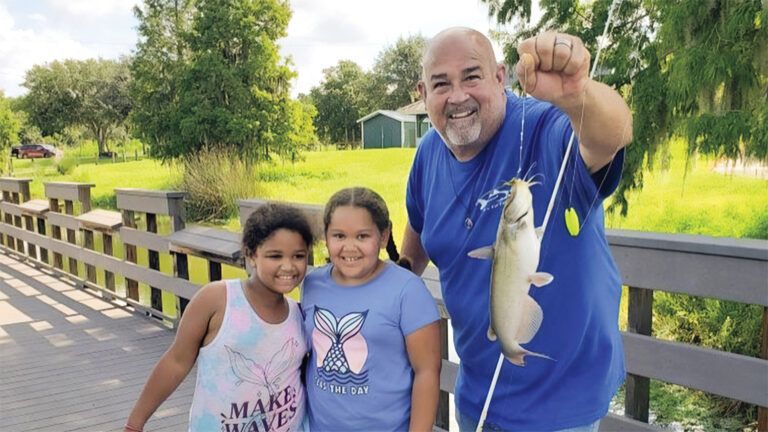Nearly seven years ago, Reid and Serita Cox, made a life-changing decision to help foster children and their caregivers.
Serita was raised in the system and the couple had dedicated plenty of long hikes, dog walks, weekends, and evenings to brainstorming how they could use their respective backgrounds — hers as a nonprofit consultant, his as a communications consultant for LinkedIn– to make a difference in that world. Then, as Reid tells Guideposts.org, a “light bulb went off.”
“I was learning all about how to create an online community,” he explains. “Serita was sort of in that zone of [knowing] what a good nonprofit could look like and what it is we should do. We’d always talked about what we thought foster care needed.”
They decided that what the system needed was its own online community to connect caregivers, kids, and social workers. That’s how their nonprofit, iFoster was born.
“There are foster families in every community. There are foster kids in every community. But they don’t have their own community,” Reid says. “They’re removed from their homes, their families, their communities, sometimes their schools, and they’re placed in a new environment and the caregivers don’t perhaps know other foster caregivers. The children don’t know other foster kids. So they’re out there on their own.”
iFoster’s online resource portal is almost like a Facebook for foster care – it not only bridges the gap, introducing caregivers, social workers, and kids looking for support, the nonprofit itself works hard to address the needs of each specific community.
“What we do on their behalf is we ask them, what is it that the community needs?” Reid explains of how his nonprofit uses its online space to frequently survey its members. “And that can vary. That can vary from one city to the next. It can vary from a formal foster caregiver to a family caregiver. But we ask the community, ‘What do you most need?’ And then we go out on their behalf and we try to get the resources and the opportunities they need to give the children they’re raising the best chance at having the same type of experiences that any child growing up in a loving nurturing home environment would have.”
The way they do that is two-fold. In bigger cities and areas where Reid and his team are based, like Southern California, they’ll physically go out into the community, setting up meetings and forums with leaders, business owners, social workers, etc. to see how people are connecting, what could be done better, and how they can facilitate those interactions.
But for the rest of iFoster’s 45,000 members (and “members” can be either a solitary caregiver or social worker with multiple cases, or entire agencies or even state governments, so the actual number of participants is probably much higher), everything is done through their website. Anyone curious about the system and the needs of the community can find helpful information (like online pamphlets, statistics about foster care, and other organizations making a difference in the space) just by visiting the site, if they’re members.
“In order for you to log into iFoster.org and become a member, it’s just a quick online form,” Reid says. “You explain to us who you are, where you live, the type of caregiver you are, whether you’re a formal foster caregiver, whether you’re a grandparent raising your grandchild, whether you’re a social worker or an agency working within the space. And then we do a little due diligence. We approve you.”
Once registered, members have access to over 500 resources provided by the nonprofit.
“Those can be things like laptops. They can be services like tutoring, free eyeglasses, orthodontia, etc., or it can be opportunities,” Reid explains. “We have an employment program where we train youth and get them jobs with over 25 major employment partners. So depending on what it is you’re looking for and where you live, you go into this site, you type in some keywords or search under categories, and it’ll show you what’s available to you.”
All of the companies iFoster works with – like Starbucks, CVS Pharmacy, and national grocery chains – are vetted by Reid and his team so families, caregivers, and social workers can trust the recommendations they give and have easier, quicker access to programs and services they need.
And because the organization regularly surveys its members, they’re able to go out to businesses and communities to advocate on their behalf. It’s how the nonprofit’s computer program was created.
“That was the very first thing that our community came back to us and said we need,” Reid says. “It’s been number one ever since we did our first survey.”
Most caregivers aren’t given the funds necessary to pay for tech equipment and the aid they are given is usually strictly regulated.
“The dollars they do get are only allowed to be spent on certain things: food, shelter, clothing, etc.,” Reid explains. “Computers unfortunately aren’t one of the items that a caregiver can give a receipt to their social worker and say, ‘Is this a legitimate expense?’ So for those reasons, kids in foster care have horrible, horrible access to computers.”
In a survey Reid and his team did of foster care youth in the state of California, only 12% of city kids and 5% of rural kids had access to a computer. So the nonprofit began reaching out to tech companies. Some offered to sell them laptops at whole sale price, others offered deals normally reserved for employees, but prices were still too high, so Cox reached out to Microsoft. The company connected them to a refurbishing partner who takes old desktops and laptops of big businesses, wipes them, and then sells them for a fraction of the cost.
For some families, that cheaper price is affordable, but for others, even a heavily discounted computer is still too expensive. So iFoster steps in again.
“We go out and we find funders,” Reid explains. “We have foundation partners and community foundations who will fund computers to give away to children in youth foster care. So we basically negotiated the product, which is the computers at a very advantageous price, got that cost structure down very low, and then for those families who still can’t afford that very low cost, we have a number of different funders who give us grants, and we spend that grant money getting computers out to kids in foster care. And the way that works is social workers identify the children and youth that they think are in greatest need, and they fill out a form. We take it to our funders. We send a computer to that kid. And we’ve donated probably about 12,000 computers that way.”
Reid has been able to chronicle the journey of countless foster kids he and Serita have come into contact with, thanks to their nonprofit. Kids like Krisha, who dropped out of school at a young age and found herself living on the streets. She told her social worker she wanted to go back to school to get her diploma and iFoster gave her a laptop to take the online courses she needed to graduate. They also got her a job at a local grocery store where she became a department manager in just two years. Krisha went with Reid and Serita to Washington, D.C. to testify in front of Congress about the needs of foster care kids and the importance of the Opening Doors For Youth Act, a bill that funds job placement programs for unemployed youths. Just a few weekends ago, the couple was able to see her get her high school diploma on stage.
Reid says that though Serita’s history as a child of the foster care system is what spurred them to take action with iFoster, they’ve come to realize that every child’s experience is unique. For them, iFoster isn’t about fixing big picture problems or giving their input on how to make the system work correctly, it’s about meeting the needs of each individual and realizing that everyone’s story is special.
“We know that every child has unique needs and that those unique needs may be shared among tens or hundreds of thousands of kids, or it may be unique to that one particular child and that one particular case,” Reid says. “But every time we hear about a need, if we can solve that for one person, it may solve it for hundreds of thousands of people. So I think it’s the fire that motivates us. Every day we talk to children and youth caregivers. We hear their stories. We see how we can help them. So every day it’s gratifying. Every day, it’s sad. But that’s the community she was raised in, and that’s the community we want to help every way we can.”






